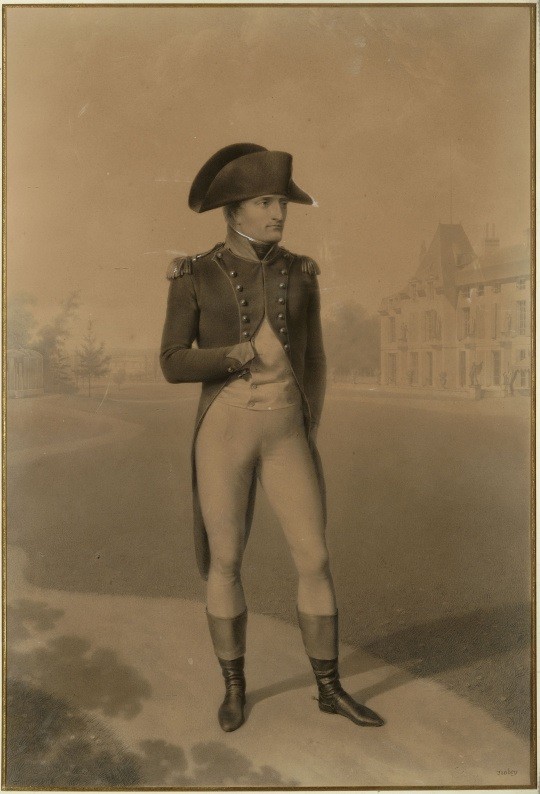According to the sources, Napoleon Bonaparte, in the midst of constructing his political image, was more sensitive to certain representations of himself, not only because they were the work of talented draughtsmen or portraitists such as Jacques-Louis David or Jean-Baptiste Isabey, but also because these artists were able to respond to the expectations of the First Consul and transcribe, beyond physical resemblance, a political message. This is the case with Isabey’s full-length portrait of the First Consul in the gardens of Malmaison. Produced between April 1801 and September 1802, this work is one of those that best embodies that period of the Consulate, during which Napoleon divided his time between the Tuileries and Malmaison (1799-1802), before the march towards the Empire.
Everything contributes to making this portrait a lasting part of the representations valued by both the authorities and public opinion: a certain truthfulness in the likeness, the expression of a determined and thoughtful face that had lost the ardour of its early youth and bears witness to the stature of the statesman, the military uniform, a guarantee of a return to order, the black felt bicorn that would distinguish him from all others and this very personal way of wearing it, namely parallel to the shoulders, and finally the gesture of the hand slipped into the waistcoat, a sign that would also be identified by posterity. In addition, thid is an image that is more intimate than official, with the sketch of Malmaison in the background. In other words, a whole range of symbolism accompanies this portrait and if Napoleon identified himself with it, it was because it served his political image.
The image of Napoleon Bonaparte was also a unique political communication tool, whether in the shape of large-format paintings of the Emperor in his coronation regalia or a miniature versions painted by the best artists on a gold box, which were distributed as presents. All means of reproduction were used, from the Sèvres “biscuit” porcelain series, to engravings, to the Epinal prints, or indeed coins and medals, which popularised the hero. Very quickly, the portrait of Napoleon the national hero supplanted that of Napoleon the man. The image of power was to transform, idealise and transfigure these features and become a unique medium of communication. Napoleon, moreover, did not want the portraits made to resemble him. “It is not the exactitude of the features, every small spot on the nose, that make the resemblance. It is the character of the physiognomy, what animates it, that must be painted” (Ce n’est pas l’exactitude des traits, un petit pois sur le nez, qui font la ressemblance. C’est le caractère de la physionomie, ce qui l’anime, qu’il faut peindre), he said to Jacques-Louis David. This multiplication of the image of power was to play an active part in the Napoleonic legend during his lifetime. And indeed a trend that would continue to be the case until the present day, thanks also to later more modern means of communication such as the cinema, which have played a large part in the spread of this legendary image.
Élisabeth Caude and Isabelle Tamisier-Vétois, July 2021
Élisabeth Caude is director of the Musée national des châteaux de Malmaison et de Bois-Préau, of the Musée Napoléonien, of the Musée Africain de l’île d’Aix, and of the Musée de la maison Bonaparte in Ajaccio, and Isabelle Tamisier-Vétois is chief curator of heritage of the Musée National des châteaux de Malmaison et de Bois-Préau and curator of the exhibition “Napoléons aux 1001 visages”, held at the Château de Malmaison 5 May – 6 September 2021, part of the “2021 Année Napoléon” label.


